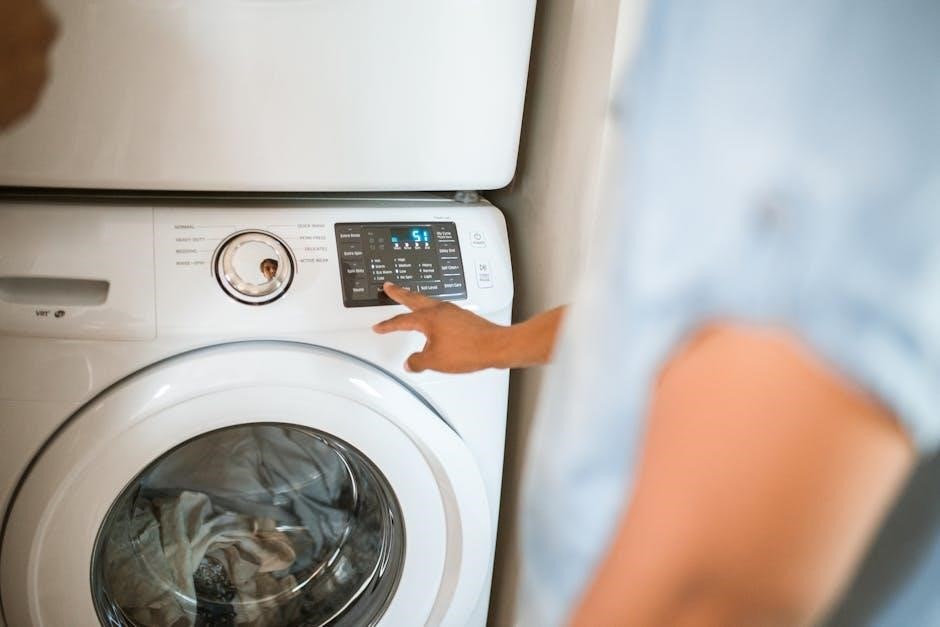Zoom Whitening is a professional dental procedure designed to remove stains and achieve a brighter smile quickly and safely. It uses advanced bleaching technology to deliver remarkable results.
1.1 What is Zoom Whitening?
Zoom Whitening is a popular, in-office dental bleaching procedure designed to safely and effectively remove surface and deep stains from teeth. It combines a hydrogen peroxide-based gel with a specialized LED light to accelerate the whitening process. The treatment is tailored to individual needs, offering customizable results. Typically, the procedure takes about an hour and can lighten teeth by up to eight shades in a single session. It is ideal for patients seeking quick, noticeable improvements in tooth color. The process is monitored by a dentist to ensure safety and comfort, making it a reliable choice for achieving a brighter, more confident smile. Zoom Whitening is widely recognized for its efficiency and ability to deliver consistent, professional-grade results.
1.2 Benefits of Zoom Whitening
Zoom Whitening offers numerous benefits, making it a preferred choice for tooth whitening. It provides rapid results, achieving up to eight shades lighter in just one visit. The procedure is safe and controlled, minimizing risks of over-bleaching or gum irritation. Customizable treatment options ensure personalized outcomes, catering to individual preferences. The combination of advanced gel and LED light technology enhances effectiveness, targeting both surface and intrinsic stains. Zoom Whitening boosts confidence by transforming smiles, making it ideal for special occasions or everyday aesthetics. It is also a quick and convenient solution for those with busy schedules, delivering professional-grade results without the need for multiple sessions. Overall, Zoom Whitening is a reliable and efficient method for achieving a brighter, more radiant smile with long-lasting results.
1.3 Importance of Post-Op Care
Proper post-operative care is essential to ensure the longevity and effectiveness of Zoom Whitening results. Following the guidelines helps minimize potential side effects like sensitivity and maintains the brightness of your smile. Avoiding staining agents, adhering to dietary restrictions, and practicing good oral hygiene are critical. Post-op care also protects the enamel and gums from irritation, ensuring overall dental health. By following instructions, you can prevent complications and sustain the aesthetic benefits of the procedure. Consistency in aftercare routines enhances the durability of the whitening effects, making the investment worthwhile. Neglecting post-op recommendations can lead to diminished results or discomfort, emphasizing the importance of compliance. Thus, post-op care is vital for achieving and maintaining optimal outcomes from Zoom Whitening.

Preparing for Zoom Whitening
Preparing for Zoom Whitening involves a thorough consultation, understanding the process, and following pre-procedure instructions to ensure optimal results and comfort during the treatment.
2.1 Consultation and Examination
The consultation is the first step in preparing for Zoom Whitening. During this meeting, your dentist will discuss your expectations, assess your oral health, and determine if Zoom Whitening is suitable for you. A thorough examination of your teeth and gums will be conducted to identify any dental issues that may need attention before the procedure. Your dentist will also explain the process, potential outcomes, and any necessary precautions. This personalized approach ensures a tailored treatment plan, addressing your unique needs and goals. It’s an opportunity to ask questions and clarify any concerns, ensuring you feel informed and comfortable moving forward. The consultation sets the foundation for a successful and satisfying Zoom Whitening experience.
2.2 Pre-Procedure Instructions
Before undergoing Zoom Whitening, your dentist will provide specific pre-procedure instructions to ensure the best results. This may include avoiding staining agents like coffee, tea, or tobacco for a certain period. You’ll also be advised to maintain good oral hygiene by brushing and flossing regularly. On the day of the procedure, arrive with clean teeth and avoid eating or drinking for at least one hour beforehand. Your dentist may also recommend desensitizing toothpaste to minimize sensitivity. It’s important to follow these guidelines carefully to enhance the effectiveness of the treatment and ensure a smooth experience. Proper preparation is key to achieving the desired outcome and maintaining the health of your teeth and gums.
2.3 What to Expect During the Procedure
During the Zoom Whitening procedure, your dentist will begin by protecting your gums and lips with a barrier. The whitening gel, containing hydrogen peroxide, will be applied to your teeth. The Zoom LED light will then be used to activate the gel, helping it penetrate the enamel and break down stains. This process is typically repeated in 15-minute intervals for about an hour. You may experience a tingling sensation or mild sensitivity, but this is usually temporary. During the treatment, you can relax, listen to music, or watch a movie. After the final cycle, the gel and protective barriers are removed, and your teeth are rinsed. Your dentist will then assess the results and provide post-procedure instructions to maintain your brighter smile.

Immediate Post-Op Care
After Zoom Whitening, avoid dark foods, beverages, and smoking for 24 hours. Use a soft toothbrush and gentle toothpaste to clean your teeth. Sensitivity may occur but is temporary.
3.1 First Few Hours After Whitening
Immediately after Zoom Whitening, your teeth may be sensitive, and the whitening gel may still be active. Avoid consuming any dark-colored foods or drinks.
Use a soft-bristled toothbrush and fluoride toothpaste to gently clean your teeth. Avoid smoking or using tobacco products, as they can stain your teeth.
Stick to a white diet, including foods like rice, bananas, and white bread, for the first 24 hours. Avoid hot beverages like coffee and tea.
If sensitivity occurs, use a desensitizing toothpaste or mouthwash. Your dentist may recommend specific products to help with discomfort.
Keep your mouth moist by drinking water to prevent dryness, which can exacerbate sensitivity. Avoid using colored mouthwashes during this period.
Rest assured, the sensitivity is temporary and should subside within a few days. Follow your dentist’s instructions carefully to ensure optimal results.
3.2 Sensitivity Management
Sensitivity after Zoom Whitening is common but temporary. To manage it, use a desensitizing toothpaste or mouthwash containing ingredients like potassium nitrate or strontium chloride.
Avoid consuming hot or cold foods and drinks for 24-48 hours. Use a soft-bristled toothbrush and gentle brushing technique to minimize discomfort.
Your dentist may provide a desensitizing gel to apply at home. Avoid biting or chewing on hard objects, as this can exacerbate sensitivity.
If sensitivity persists, consider using over-the-counter pain relievers like ibuprofen, but consult your dentist before doing so.
Stick to room-temperature foods and drinks during the initial recovery period. Sensitivity typically diminishes within a few days.
For severe or prolonged sensitivity, contact your dentist for further guidance or treatment options.
3.3 Temporary Tooth Color Changes
After Zoom Whitening, teeth may appear temporarily blotchy or uneven due to the bleaching agents penetrating the enamel. This is a normal reaction and typically subsides within a few days.
To minimize the appearance of color changes, avoid consuming staining substances like coffee, tea, or red wine during the initial recovery period.
Practicing good oral hygiene, including regular brushing and flossing, can help maintain even color distribution and prevent re-staining.
If uneven color persists beyond a week, consult your dentist for potential touch-up treatments or additional care.
Temporary color changes are not a cause for concern and do not affect the long-term results of the whitening procedure.
For optimal outcomes, adhere to your dentist’s post-op instructions and attend any recommended follow-up appointments.

Short-Term Post-Op Instructions
Follow specific guidelines to protect your teeth and maintain results, including avoiding certain foods, practicing oral hygiene, and managing sensitivity as directed by your dentist.
4.1 Diet and Food Restrictions
After Zoom Whitening, adhere to a diet rich in non-staining foods for the first 24-48 hours. Opt for white or light-colored foods like rice, pasta, bananas, and white meats. Avoid staining agents such as coffee, tea, red wine, and berries for at least 48 hours. Acidic foods and beverages should also be avoided to minimize sensitivity. Smoking is highly discouraged, as it can stain teeth and reduce the effectiveness of the treatment. For long-term results, maintain a balanced diet and be cautious with staining foods. Proper dietary choices will help preserve the brightness and health of your teeth, ensuring the longevity of your Zoom Whitening results.
4.2 Avoiding Staining Agents
After Zoom Whitening, it is crucial to avoid staining agents to maintain your results. Common culprits include coffee, tea, red wine, berries, and tobacco products, which can discolor your teeth. For the first 48 hours, completely avoid these items, as your teeth are more porous and susceptible to stains. Even after this period, minimize consumption or use a straw to reduce contact with your teeth. Smoking should be avoided entirely, as it not only stains teeth but also harms oral health. By limiting exposure to staining agents, you can preserve the brightness and longevity of your Zoom Whitening treatment. This precaution is essential for achieving and maintaining the best possible outcomes.

4.3 Oral Hygiene Practices
Maintaining proper oral hygiene is essential after Zoom Whitening to preserve your results and overall dental health. Brush your teeth twice daily with a fluoride toothpaste and a soft-bristled toothbrush, avoiding abrasive products that could damage your enamel. Pay special attention to areas where the teeth and gums meet. Floss daily to remove plaque and food particles between teeth, which can cause staining and decay. Regular dental check-ups are also crucial for professional cleanings and exams. To further protect your teeth, use a straw when consuming staining beverages like coffee or tea to minimize contact. Additionally, consider using a mouthwash if recommended by your dentist. By adhering to these practices, you can maintain the brightness of your smile and ensure long-lasting results from your Zoom Whitening treatment.

Long-Term Maintenance

Maintaining proper oral hygiene is crucial after Zoom Whitening to sustain your results and overall dental health. Brush your teeth twice daily with fluoride toothpaste and a soft-bristled toothbrush, avoiding abrasive products that could harm your enamel. Focus on areas where the teeth and gums meet to prevent plaque buildup. Floss daily to remove food particles and plaque between teeth, which can lead to staining and decay. Regular dental check-ups are essential for professional cleanings and exams. To further protect your teeth, use a straw when consuming staining beverages like coffee or tea to reduce contact. Consider using a mouthwash if recommended by your dentist. By following these practices, you can maintain the brightness of your smile and ensure long-lasting results from your Zoom Whitening treatment.
5.1 Maintaining Whitening Results
To maintain the brightness of your smile after Zoom Whitening, consistent care is essential. Avoid consuming heavily pigmented foods and drinks, such as coffee, tea, and red wine, as they can stain teeth. Use a straw for dark beverages to minimize contact with your teeth. Regular dental cleanings and proper oral hygiene practices, like brushing twice daily with fluoride toothpaste, are crucial. Touch-up treatments may be needed every 6-12 months to sustain results. Additionally, avoid smoking or using tobacco products, as they can discolor teeth. By adopting these habits, you can enjoy a radiant, white smile for a longer period. Remember, maintaining your results requires a combination of good oral hygiene and mindful lifestyle choices.
5.2 Touch-Up Treatments
Touch-up treatments are occasional procedures designed to maintain the brightness of your teeth after Zoom Whitening. These treatments are typically shorter and less intensive than the initial procedure. They involve applying the Zoom Whitening gel to your teeth, either in-office or at home, to refresh and enhance the color. Touch-ups are recommended every 6-12 months, depending on your lifestyle and dietary habits. They are a cost-effective way to maintain your results without undergoing the full procedure again. Regular touch-ups can help combat natural staining from food, drinks, and aging. Your dentist may provide custom-fitted trays and gel for at-home touch-ups, allowing you to maintain your smile’s brightness in the comfort of your own home; By incorporating touch-up treatments into your routine, you can ensure your teeth remain vibrant and white for years to come.

5.3 Lifestyle Adjustments for Sustained Results

To maintain the longevity of your Zoom Whitening results, certain lifestyle adjustments are essential. Avoid consuming staining agents like coffee, tea, red wine, and berries, as they can discolor your teeth over time. Smoking and tobacco use should also be avoided, as they significantly contribute to tooth staining. Using a straw when drinking dark-colored beverages can help minimize contact with your teeth. Regular dental checkups are crucial to monitor your progress and address any potential issues early. Additionally, incorporating a whitening toothpaste or mouthwash into your daily routine can help maintain your results. Touch-up treatments, as recommended by your dentist, will also play a role in sustaining your smile’s brightness. By combining good oral hygiene practices with mindful lifestyle choices, you can enjoy a radiant, white smile for an extended period.
6.1 Causes of Sensitivity After Whitening
Tooth sensitivity after Zoom Whitening is a common, temporary side effect. It occurs when the bleaching agents penetrate the enamel and reach the dentin, irritating the nerve endings. The dehydration of the tooth structure during the procedure can also contribute to sensitivity. Additionally, the removal of surface stains may expose microscopic areas of the dentin, making teeth more responsive to temperature changes. Individuals with pre-existing conditions, such as gum recession, cracked teeth, or decay, may experience heightened sensitivity. The good news is that this discomfort typically subsides within a few days. In the meantime, using desensitizing toothpaste or products containing potassium nitrate can help alleviate symptoms. Your dentist may also recommend specialized treatments to address prolonged sensitivity.
6.2 Remedies for Sensitivity
To alleviate sensitivity after Zoom Whitening, several remedies can be effective. Desensitizing toothpaste containing ingredients like potassium nitrate or strontium chloride can help block nerve endings. Fluoride gels or varnishes may also be recommended by your dentist to strengthen tooth enamel and reduce sensitivity. Over-the-counter pain relievers, such as ibuprofen or acetaminophen, can provide temporary relief. Avoiding extreme temperatures in food and beverages during the initial recovery period is crucial. Additionally, using a soft-bristled toothbrush and gentle brushing techniques can minimize irritation. In some cases, your dentist may prescribe a desensitizing mouthwash or toothpaste for at-home use. It’s important to follow your dentist’s instructions and avoid aggressive dental products, as they can exacerbate sensitivity. If discomfort persists beyond a few days, contact your dentist for further evaluation and treatment options.
6.3 When to Seek Professional Help
If sensitivity persists beyond a few days or becomes severe, it’s important to contact your dentist promptly. Severe pain, uneven whitening results, or gum irritation that doesn’t subside may indicate complications. Additionally, if you notice any unusual side effects, such as blistering or prolonged discomfort, seek professional advice. Your dentist can assess the situation and provide tailored solutions, such as adjusting the treatment or recommending additional care. If sensitivity interferes with daily activities or worsens over time, professional intervention is necessary to ensure proper healing and comfort. Don’t hesitate to reach out if you have concerns about your post-op recovery or results.

Common Questions and Concerns
Common questions include how long results last, potential side effects, and if teeth can be whitened again. Address these concerns by following the provided guide or consulting your dentist.
7.1 How Long Do Results Last?
The longevity of Zoom Whitening results varies depending on factors like diet, oral hygiene, and lifestyle. With proper care, results can last up to three years. Avoiding staining agents like coffee, tea, and tobacco helps maintain brightness. Regular brushing, flossing, and touch-up treatments can extend results; Some patients may experience faster fading due to enamel thickness or dietary habits. To sustain whiteness, limit intake of dark-colored foods and beverages. Using a straw for staining drinks can reduce contact with teeth. Overall, consistent oral hygiene and lifestyle adjustments are key to preserving the whitening effects. Results may diminish over time, but following post-op instructions and maintenance tips can help keep your smile bright for a longer period.
7.2 Are There Side Effects?
Common side effects of Zoom Whitening include temporary tooth sensitivity and gum irritation. Sensitivity typically subsides within a few days post-procedure. Gums may feel irritated due to the whitening gel, but this usually resolves quickly. Rarely, some patients experience mild discomfort or a metallic taste, which fades shortly. To minimize discomfort, follow all post-op instructions carefully. Your dentist may recommend desensitizing toothpaste or gels to alleviate any sensitivity. It’s important to discuss any concerns or pre-existing sensitivities with your dentist before the procedure to ensure the best outcome. Most side effects are mild and temporary, making Zoom Whitening a safe and effective option for many patients.
7.3 Can I Whiten My Teeth Again?
If you desire a brighter smile after your initial Zoom Whitening treatment, you can undergo another session, but it’s advisable to wait at least two weeks to allow your teeth to recover. Your dentist will assess your teeth’s condition and recommend the optimal timing. Touch-up treatments are typically shorter than the initial procedure, focusing on maintaining or enhancing your current shade. For best results, follow post-op care instructions diligently to preserve your whitening outcomes. Regular touch-ups can help sustain your desired brightness, but it’s crucial to avoid over-whitening, which can lead to tooth sensitivity or damage. Always consult your dentist to ensure safe and effective repeat treatments tailored to your dental health needs.
Zoom Whitening is an effective, safe procedure for achieving a dazzling smile. By following post-op instructions and maintaining proper care, you can enjoy long-lasting, brilliant results. Always consult your dentist for personalized advice.
8.1 Final Tips for Optimal Results
To ensure the best outcome from your Zoom Whitening treatment, maintain consistent oral hygiene, avoid staining agents, and attend follow-up appointments. Use desensitizing toothpaste if needed and consider touch-ups to maintain brightness. Avoid smoking and limit coffee, tea, and red wine consumption to prevent discoloration. For sustained results, rinse your mouth with water after consuming staining foods or drinks. Regular dental cleanings and proper at-home care are essential. If sensitivity persists, consult your dentist for recommendations. Remember, individual results may vary, so tailor your care routine based on your dentist’s advice. By following these tips, you can enjoy a radiant, white smile for years to come. Always prioritize your dental health and maintain open communication with your dentist for any concerns.
8.2 Importance of Following Instructions
Adhering to your dentist’s post-op instructions is crucial for achieving the best possible outcomes from your Zoom Whitening treatment. These guidelines are designed to minimize side effects, ensure long-lasting results, and protect your dental health. Ignoring recommendations can lead to complications such as increased sensitivity or reduced whitening effectiveness. By following the advice, you can maintain the brightness of your teeth and prevent discoloration. Proper care also helps in avoiding common issues like uneven results or gum irritation. Remember, your dentist tailors these instructions to your specific needs, so staying proactive and committed to your oral care routine is essential. If you have any doubts or concerns, always consult your dentist for clarification. Your dedication to these instructions will significantly impact the success and longevity of your Zoom Whitening experience.
8.3 Contacting Your Dentist
Contacting your dentist after Zoom Whitening is essential for addressing any concerns or questions you may have. Your dentist is your primary resource for ensuring the best outcomes and maintaining your oral health. If you experience unusual sensitivity, discomfort, or notice any unexpected changes, reaching out promptly can help prevent complications. Many dentists provide emergency contact options for urgent situations. Additionally, your dentist can offer personalized advice tailored to your needs, such as adjusting your post-op care routine or addressing specific concerns. Regular follow-ups are also crucial for monitoring the longevity of your whitening results. By staying in communication, you can ensure your smile remains healthy and vibrant. Always keep your dentist’s contact information handy and don’t hesitate to reach out if you need guidance or reassurance.